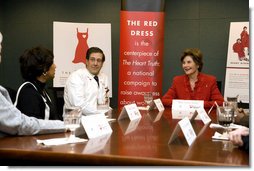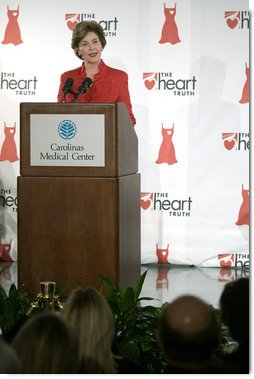
 |
For Immediate Release
Office of the First Lady
February 15, 2006
Mrs. Bush's Remarks in Recognition of American Heart Month
Carolinas Medical Center
Charlotte, North Carolina
2:42 P.M. EST
MRS. BUSH: Thank you, Lois. Thanks so much for sharing your story with us. It's really important that women hear the lessons that Lois learned and take action in their own lives.
I want to acknowledge Michael Tarwater, the President and CEO of Carolinas Health Care System. Thank you very, very much. Thanks for letting me join you here. Former Governor James Martin is in the audience out here. He's the Vice President of Carolinas Health Care Center now. The Mayor of Charlotte is here. Thank you, Mayor, Pat McCrory, for joining us today. We appreciate it very much. Suzanne Freeman, the President of Carolinas Medical Center, and Dr. Rose, the Lead Cardiologist and Medical Director for the Heart of a Woman Campaign.
 There is perhaps no better time to talk about the importance of
good heart health than around Valentine's Day. It's a great day to tell
someone you love them and that you want them to be healthy. And
actually, that's what happens across the United States. Women tell
their husbands that they love them -- (laughter) -- and if any husbands
suffer any symptoms of a heart attack, the women are the ones to make
sure, the wives are the ones to make sure they get right to the
emergency room. But it's time for husbands to tell women the same
thing, and for each of us to tell our sisters and our mother and our
friends that heart disease also affects women, and that one of the
reasons more women die than men now every year from heart disease in the United States is because women wait. They think that it's just anxiety
or reflux or something like that, and they don't really realize that
they need to get to the emergency room just as fast as they'd send their
husband to the emergency room.
There is perhaps no better time to talk about the importance of
good heart health than around Valentine's Day. It's a great day to tell
someone you love them and that you want them to be healthy. And
actually, that's what happens across the United States. Women tell
their husbands that they love them -- (laughter) -- and if any husbands
suffer any symptoms of a heart attack, the women are the ones to make
sure, the wives are the ones to make sure they get right to the
emergency room. But it's time for husbands to tell women the same
thing, and for each of us to tell our sisters and our mother and our
friends that heart disease also affects women, and that one of the
reasons more women die than men now every year from heart disease in the United States is because women wait. They think that it's just anxiety
or reflux or something like that, and they don't really realize that
they need to get to the emergency room just as fast as they'd send their
husband to the emergency room.
February is American Heart Month, and I've joined the National Heart, Lung and Blood Institute's Heart Truth campaign to share this message with women across the country, which is that heart disease is the leading cause of death among women in the United States.
I was surprised when I first heard this. Like many women, I assumed that heart disease was a man's disease and that cancer was what we would fear the most. Yet heart disease kills more women in our country than all forms of cancer combined. And this year alone, nearly half-a-million women will die from cardiovascular disease in America -- about 60,000 more women than men. But when it comes to heart disease, education, prevention, and even a little red dress can save lives.
I'm thrilled to see so many people wearing red or wearing their red dress pin. Nothing attracts attention like a red dress. Thanks to The Heart Truth campaign, the red dress has become a national symbol of women's good heart health, and women are getting and sharing the message.
 One of the first events I did for The Heart Truth campaign was in
2003. I visited St. Luke's Hospital in Kansas City to meet with local
women, and I learned firsthand the incredible difference each one of us
can make.
One of the first events I did for The Heart Truth campaign was in
2003. I visited St. Luke's Hospital in Kansas City to meet with local
women, and I learned firsthand the incredible difference each one of us
can make.
When Joyce Cullen woke in the middle of the night with chest pains, her first thought wasn't a heart attack. She had been to the doctor a couple of days before, complaining about fatigue, but she'd been given a clean bill of health. But that night, Joyce had watched the news coverage of my visit to Kansas City, and she had learned the symptoms of heart disease. So she said when she woke up, she said to her husband, I think I'm having a heart attack, let's pray and go to the hospital. (Laughter.) So they did. And she was having a heart attack. Joyce had surgery, and she's in good health today. And now she proudly wears red and she shares her story with women all around Kansas City and around the country.
Thousands of women are learning about heart disease through The Heart Truth campaign. According to a new poll conducted by Lifetime Television and the National Heart, Lung and Blood Institute, today, more than 56 percent of American women correctly identified heart disease as the leading cause of death. Additionally, nearly 40 percent of women now recognize the red dress as the national symbol for women and heart disease awareness.
We're making great progress with The Heart Truth campaign, but there are still too many women who believe that heart disease will never happen to them. Here in Charlotte, just 28 percent of women age 40 to 70 recognize their risk for heart disease. And shockingly, more than half of the women who are truly at risk are not aware of their vulnerability. I'm thrilled that the Carolinas Heart Institute launched a program called "Heart of a Woman" to increase awareness of heart disease and to help women recognize their risk factors.
We have to alert women everywhere to the seriousness of heart disease, and especially to the dangers of having multiple risk factors. The most common risk factors include being overweight, having high blood cholesterol, and high blood pressure. In Charlotte, more than one-third of women at risk for heart disease have more than one risk factor. Nationally, 80 percent of women age 40 to 60 have one or more risk factors for heart disease.
Having multiple risk factors dramatically increases a woman's chance of developing heart disease. A recent study showed that women with two or more risk factors have a 50 percent risk for heart disease, compared to barely an eight percent risk for women who have no risk factors.
 African American and Hispanic women have higher rates of some risks
for heart disease and are disproportionately affected by the disease.
Last year we unveiled The Heart Truth's women of color initiative to
help more African American and Hispanic women understand The Heart Truth
and take action to improve their health. This year we're launching
another new initiative called the "First Ladies of the Church," which
will work with women in the faith community to get the message out to
African American women. And the Reverend Brenda Timberlake is the North
Carolina head of the First Ladies of the Church. Where are you,
Reverend? There she is, right here on the aisle. (Applause.)
African American and Hispanic women have higher rates of some risks
for heart disease and are disproportionately affected by the disease.
Last year we unveiled The Heart Truth's women of color initiative to
help more African American and Hispanic women understand The Heart Truth
and take action to improve their health. This year we're launching
another new initiative called the "First Ladies of the Church," which
will work with women in the faith community to get the message out to
African American women. And the Reverend Brenda Timberlake is the North
Carolina head of the First Ladies of the Church. Where are you,
Reverend? There she is, right here on the aisle. (Applause.)
This is the good news, though. The good news is that heart disease is treatable, and it's often preventable. Studies show that by eating a healthy diet, exercising, not smoking, maintaining a healthy weight, and visiting your doctor to find what your risk factors are, women can reduce their risk for heart disease by as much as 82 percent. The sad news is, though, that only about three percent of American women actually do every one of those things -- eat a healthy diet, not smoke, exercise, see your doctor to see what your risk factors are, and maintain a healthy weight. And by healthy, you know what that means. (Laughter.) A lower weight, actually.
The first thing you can do to improve your health is to attend the National Women's Heart Day Health Fair this Friday. Charlotte is one of the 14 cities around the country that's hosting a Heart Day Health Fair. It will be this Friday at the Charlotte Convention Center, and it's sponsored by Sister to Sister, a national partner of The Heart Truth. The fair will provide free screenings. You can get your blood pressure taken, your cholesterol -- blood cholesterol rate screened, as well as other information about helpful tips on how to prevent and reduce your risk for heart disease.
I encourage all of you also to get out your favorite red dress, and to tell every woman you know that heart disease can be prevented. Together we can make a lifesaving difference, through education and prevention, and we can show American women that being healthy never goes out of style.
Thank you all very, very much. Thanks so much for getting the word out to American women. Thanks a lot. (Applause.)
END 2:51 P.M. EST